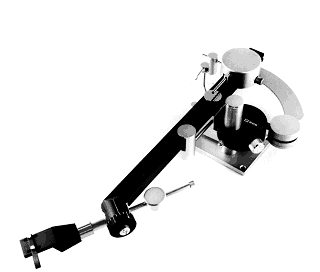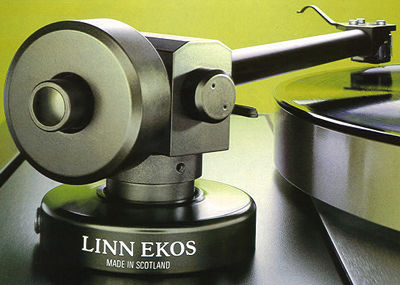The story begins with the advent of Linn’s Ittok LVII tonearm toward the end of the 1970s. In an analog scene dominated by the SME 3009S2, which existed on practically every turntable motor unit at the time, it put the cat among the pigeons. There was also the Grace G707, which had been Linn’s preferred tube (and was even imported from Japan by them) prior to the Ittok’s release, although it had only moderate success. The Ittok was your nemesis if you were a ‘superarm’ in 1979…
When a number of people began raving about Scott Strachan’s Syrinx PU2, it came as no surprise. In straight A-B dems in dealer showrooms, this strange creature was outperforming the hitherto impregnable Ittok. The Syrinx, moreover, was neither from the established English ‘old guard,’ such as SME, nor from the new Glasgow establishment, symbolised by Linn. Rather, approximately fifty miles down the road in Edinburgh, Syrinx Precision Instruments made pregnancy scanners and ultrasonic measuring equipment.
Ittok was always a multi-colored device. It sucked away part of the richness and tonal vitality from records and replaced it with an appealing boom-tizz that made rock music seem thrilling, but didn’t work as well with classical or jazz, which required more nuance. The Syrinx, on the other hand, was a sweeter and more seductive affair, with less brawn and more intelligence. It was an unusual design. Whereas SME and Linn arms were simple and straightforward to set up and get the most out of, getting a PU2 into perfect alignment was a Herculean undertaking. Part of the issue was that the lateral movement bearings were not on the same axis as the vertical movement bearings. The fact that one side of the horizontal and vertical bearing sets was rubber mounted and the other was not was even more odd. The concept was that the energy in each bearing set would have a single ground path.
The brass arm tube was a long, spindly tube that lacked any sort of headshell. Headshells, Syrinx reasoned, are ugly, bendy, resonant objects that should be avoided. To wit, the PU2 had an aluminium headlock with a fingerlift that was threaded to accept cartridge mounting bolts. Pushing the cartridge up and down the end of the armtube helped position it. You won’t find a more obnoxious design in this case, or in many others. Still, it did a fantastic job of improving sound quality. The Ittok, on the other hand, felt like a Sony Biotracer arm, replete with stylus pressure and height adjustment via remote control!
If all of this appears to be very Heath Robinson, Syrinx outdid itself with the Mass Ring. It was a half-hearted attempt to raise the effective mass of the PU2 in order for it to get the best out of the new breed of moving coil cartridges that were becoming popular at the time. It was essentially a heavy weight that bolted – via three fiddly little allen bolts – onto the rear of the bearing housing. The method of attaching the Mass Ring to the PU2 was difficult enough to make neurosurgery look like a game of scalpel. All was forgiven when Hadcock unipivot returned!
When the Syrinx was released to the general public in 1980, it cost £198.38 plus £22.54 for the Mass Ring. That put it on par with the £253 Linn Ittok and well ahead of its domestic rivals. Many people thought it was superior when properly set up, with a significantly more ‘unipivot-like’ sound that made vinyl sing like never before. It sounded great to my ears for approximately five minutes before it got out of fine adjustment again. The Syrinx PU3 was a significant upgrade that addressed the PU2’s variability while also sounding better. While secondhand Linn Ittoks may cost upwards of £400, old PU2s can be found for as little as £100, making them a bargain if you’re a fiddler. Saner souls might want to spend roughly £200 on a PU3 and just listen to their music.







